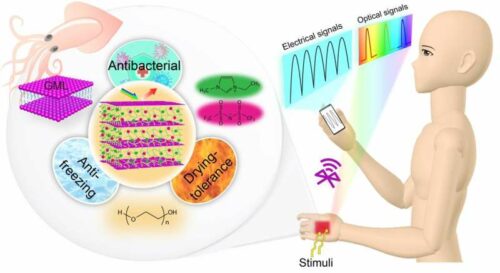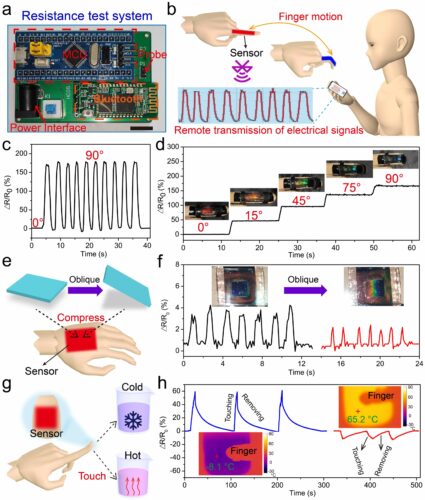Researchers have developed a highly flexible and temperature resistant artificial skin which also possesses antibacterial properties.

Countless hardware and software solutions created over the past decades draw inspiration from animals and natural phenomena. This includes electronic skins (e-skins), flexible and stretchable electronic circuits designed to replicate the human sense of touch or accurately detect the tactile properties of objects.
Researchers from Dalian University of Technology have designed a new highly flexible and temperature resistant artificial skin, that also possesses antibacterial properties. This new biological skin transforms environmental information into bioelectrical signals and transmits it to the nervous system for perceiving external strain, tactile sensation, vibration, temperature, etc. In addition to these bioelectrical signals, particularly, cephalopod (e.g., squid) skin can further actively perceive the complex environment through color change, for communication, courtship, camouflage, and even thermoregulation.
The skin is based on a photonic-ionic system that allows it to synchronously output optical and electrical signals. In addition, it also integrates monoglyceride laurate molecules, which have antibacterial qualities, allowing it to destroy over 99.9% of bacteria and fungus. When this skin is exposed to external stimuli, for instance when it touches a surface, the lattice of its photonic nanostructure changes quickly, resulting in a rapid change of color. Concurrently, the ion transport and mobility in the skin also change, ultimately enabling a synchronous optical and electrical dual-signal response.

The photo-ionic skin contains the monoglyceride laurate that can kill almost all gram-positive bacteria and fungi, a particularly valuable function for the development of prostheses and other medical technologies.
In initial evaluations, the artificial skin created by Dr. Wenbin Niu and his colleagues achieved highly promising results. The researchers found that its synchronous output of two signals even allowed it to distinguish between different environmental and tactile stimuli. In the future, this new skin could be used to enhance the capabilities of a broad range of devices, including wearable devices, soft robots, e-prosthetic limbs, and interfaces for human computer interaction.
Reference : Yunpeng Wang et al, Squid-inspired photonic-ionic skin with anti-freezing, drying-tolerance, and antibacterial abilities for wirelessly interactive multi-sensing, Chemical Engineering Journal (2023). DOI: 10.1016/j.cej.2023.142290






